压电陶瓷性能参数
- 格式:pdf
- 大小:166.76 KB
- 文档页数:12

压电材料的主要性能参数(1) 介电常数ε介电常数是反映材料的介电性质,或极化性质的,通常用ε来表示。
不同用途的压电陶瓷元器件对压电陶瓷的介电常数要求不同。
例如,压电陶瓷扬声器等音频元件要求陶瓷的介电常数要大,而高频压电陶瓷元器件则要求材料的介电常数要小。
介电常数ε与元件的电容C ,电极面积A 和电极间距离t 之间的关系为ε=C ·t/A式中C ——电容器电容;A ——电容器极板面积;t ——电容器电极间距当电容器极板距离和面积一定时,介电常数ε越大,电容C 也就越大,即电容器所存储电量就越多。
由于所需的检测频率较低,所以ε应大一些。
因为ε大,C 就相应大,电容器充放电时间长,频率就相应低。
(2)压电应变常数压电应变常数表示在压电晶体上施加单位电压时所产生的应变大小: 31(/)t d m V U= 式中 U ——施加在压电晶片两面的压电;△t ——晶片在厚度方向的变形。
压电应变常数33d 是衡量压电晶体材料发射性能的重要参数。
其值大,发射性能好,发射灵敏度越高。
(3)压电电压常数33g压电电压常数表示作用在压电晶体上单位应力所产生的压电梯度大小:31(m/N)P U g V P=• 式中 P ——施加在压电晶片两面的应力;P U —— 晶片表面产生的电压梯度,即电压U 与晶片厚度t 之比,P U =U/t 。
压电电压常数33g 是衡量压电晶体材料接收性能的重要参数。
其值大,接收性能好,接收灵敏度高。
(4)机械品质因数机械品质因数也是衡量压电陶瓷的一个重要参数。
它表示在振动转换时材料内部能量消耗的程度。
产生损耗的原因在于内摩擦。
m E E θ=储损m θ值对分辨力有较大的影响。
机械品质因数越大,能量的损耗越小,晶片持续振动时间长,脉冲宽度大,分辨率低。
(5)频率常数由驻波理论可知,压电晶片在高频电脉冲激励下产生共振的条件是: 022LL C t f λ== 式中 t ——晶片厚度;L λ——晶片中纵波波长;L C ——晶片中纵波的波速; 0f ——晶片固有频率。
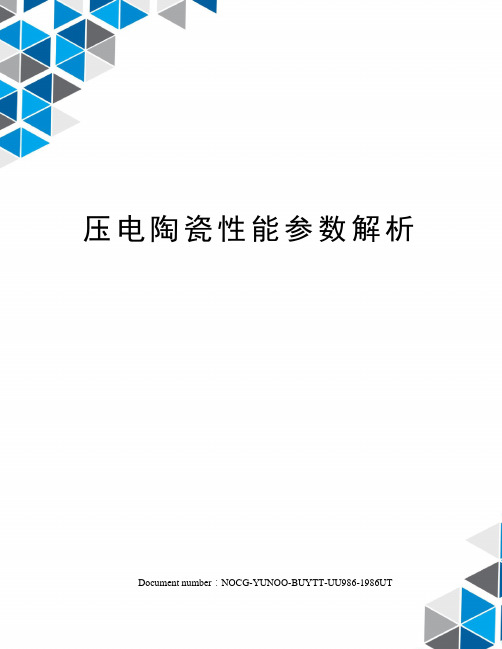
压电陶瓷性能参数解析 Document number:NOCG-YUNOO-BUYTT-UU986-1986UT在机械自由条件下,测得的介电常数称为自由介电常数,在εT表示,上角标T表示机械自由条件。
在机械夹持条件下,测得的介电常数称为夹持介电常数,以εS表示,上角标S表示机械夹持条件。
由于在机械自由条件下存在由形变而产生的附加电场,而在机械受夹条件下则没有这种效应,因而在两种条件下测得的介电常数数值是不同的。
根据上面所述,沿3方向极化的压电陶瓷具有四个介电常数,即ε11T,ε33T,ε11S,ε11S。
(2)介质损耗介质损耗是包括压电陶瓷在内的任何介质材料所具有的重要品质指标之一。
在交变电场下,介质所积蓄的电荷有两部分:一种为有功部分(同相),由电导过程所引起的;一种为无功部分(异相),是由介质弛豫过程所引起的。
介质损耗的异相分量与同相分量的比值如图1-1所示,Ic为同相分量,IR为异相分量,Ic与总电流I的夹角为δ,其正切值为(1-4)式中,ω为交变电场的角频率,R为损耗电阻,C为介质电容。
由式(1-4)可以看出,I R大时,tanδ也大;I R小时tanδ也小。
通常用tanδ来表示的介质损耗,称为介质损耗正切值或损耗因子,或者就叫做介质损耗。
处于静电场中的介质损耗来源于介质中的电导过程。
处于交变电场中的介质损耗,来源于电导过程和极化驰豫所引起的介质损耗。
此外,具有铁电性的压电陶瓷的介质损耗,还与畴壁的运动过程有关,但情况比较复杂,因此,在此不予详述。
(3)弹性常数压电陶瓷是一种弹性体,它服从胡克定律:“在弹性限度范围内,应力与应变成正比”。
设应力为T,加于截面积A的压电陶瓷片上,其所产生的应变为S,则根据胡克定律,应力T与应变S之间有如下关系S=sT(1-5)T=cS(1-6)式中,S为弹性顺度常数,单位为m2/N;C为弹性劲度常数,单位为N/m2。
但是,任何材料都是三维的,即当施加应力于长度方向时,不仅在长度方向产生应变,宽度与厚度方向上也产生应变。
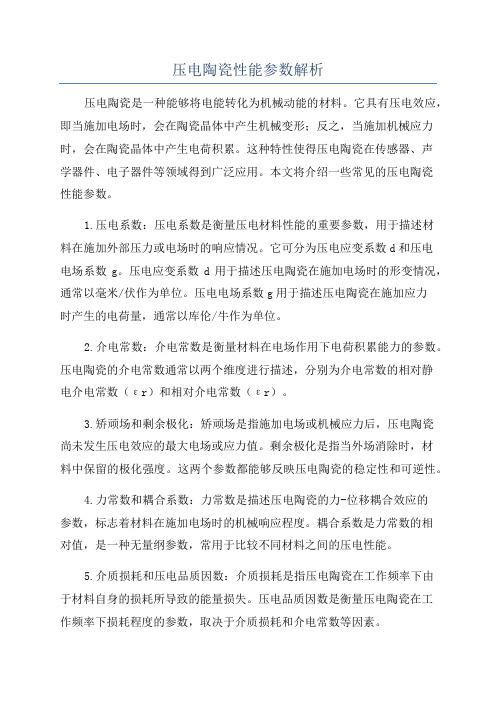
压电陶瓷性能参数解析压电陶瓷是一种能够将电能转化为机械动能的材料。
它具有压电效应,即当施加电场时,会在陶瓷晶体中产生机械变形;反之,当施加机械应力时,会在陶瓷晶体中产生电荷积累。
这种特性使得压电陶瓷在传感器、声学器件、电子器件等领域得到广泛应用。
本文将介绍一些常见的压电陶瓷性能参数。
1.压电系数:压电系数是衡量压电材料性能的重要参数,用于描述材料在施加外部压力或电场时的响应情况。
它可分为压电应变系数d和压电电场系数g。
压电应变系数d用于描述压电陶瓷在施加电场时的形变情况,通常以毫米/伏作为单位。
压电电场系数g用于描述压电陶瓷在施加应力时产生的电荷量,通常以库伦/牛作为单位。
2.介电常数:介电常数是衡量材料在电场作用下电荷积累能力的参数。
压电陶瓷的介电常数通常以两个维度进行描述,分别为介电常数的相对静电介电常数(εr)和相对介电常数(εr)。
3.矫顽场和剩余极化:矫顽场是指施加电场或机械应力后,压电陶瓷尚未发生压电效应的最大电场或应力值。
剩余极化是指当外场消除时,材料中保留的极化强度。
这两个参数都能够反映压电陶瓷的稳定性和可逆性。
4.力常数和耦合系数:力常数是描述压电陶瓷的力-位移耦合效应的参数,标志着材料在施加电场时的机械响应程度。
耦合系数是力常数的相对值,是一种无量纲参数,常用于比较不同材料之间的压电性能。
5.介质损耗和压电品质因数:介质损耗是指压电陶瓷在工作频率下由于材料自身的损耗所导致的能量损失。
压电品质因数是衡量压电陶瓷在工作频率下损耗程度的参数,取决于介质损耗和介电常数等因素。
6.工作温度范围:工作温度范围是指压电陶瓷在正常工作条件下可以承受的温度范围。
这是一个重要的参数,因为一些压电材料在高温或低温环境中性能会发生变化。
以上是一些常见的压电陶瓷性能参数。
不同的应用场景对这些参数的需求也有所不同,因此在选用压电陶瓷材料时,需要根据具体的应用需求对这些性能参数进行综合考虑。
压电陶瓷的性能参数对材料的性能和应用特性有着重要的影响,因此对于压电材料的研究和理解是非常重要的。
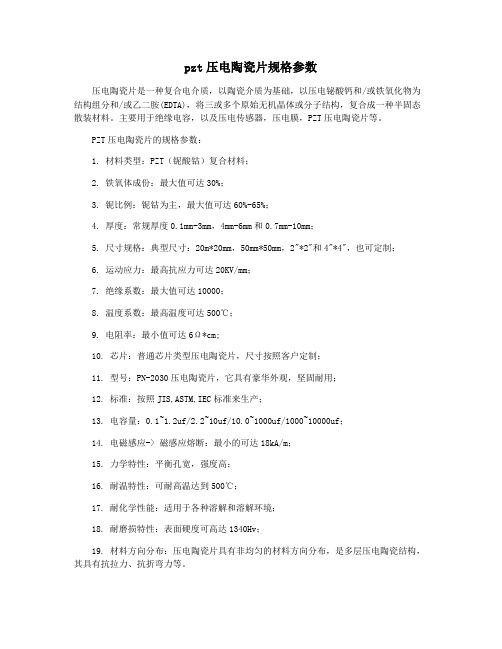
pzt压电陶瓷片规格参数压电陶瓷片是一种复合电介质,以陶瓷介质为基础,以压电铋酸钙和/或铁氧化物为结构组分和/或乙二胺(EDTA),将三或多个原始无机晶体或分子结构,复合成一种半固态散装材料。
主要用于绝缘电容,以及压电传感器,压电膜,PZT压电陶瓷片等。
PZT压电陶瓷片的规格参数:1. 材料类型:PZT(铌酸钴)复合材料;2. 铁氧体成份:最大值可达30%;3. 铌比例:铌钴为主,最大值可达60%-65%;4. 厚度:常规厚度0.1mm-3mm,4mm-6mm和0.7mm-10mm;5. 尺寸规格:典型尺寸:20m*20mm,50mm*50mm,2"*2"和4"*4",也可定制;6. 运动应力:最高抗应力可达20KV/mm;7. 绝缘系数:最大值可达10000;8. 温度系数:最高温度可达500℃;9. 电阻率:最小值可达6Ω*cm;10. 芯片:普通芯片类型压电陶瓷片,尺寸按照客户定制;11. 型号:PN-2030压电陶瓷片,它具有豪华外观,坚固耐用;12. 标准:按照JIS,ASTM,IEC标准来生产;13. 电容量:0.1~1.2uf/2.2~10uf/10.0~1000uf/1000~10000uf;14. 电磁感应-> 磁感应熔断:最小的可达18kA/m;15. 力学特性:平衡孔宽,强度高;16. 耐温特性:可耐高温达到500℃;17. 耐化学性能:适用于各种溶解和溶解环境;18. 耐磨损特性:表面硬度可高达1340Hv;19. 材料方向分布:压电陶瓷片具有非均匀的材料方向分布,是多层压电陶瓷结构,其具有抗拉力、抗折弯力等。
20. 电子特性:压电陶瓷片具有高磁性、耐磁变分布特性,并且有一定的电子特性;21. 遗传特性:压电陶瓷片具有较好的遗传性能,具有好的温度稳定性和绝缘性;22. 特殊性能:压电陶瓷片具有可调性良好的特性,可根据用户的不同需求而定制压电陶瓷片。
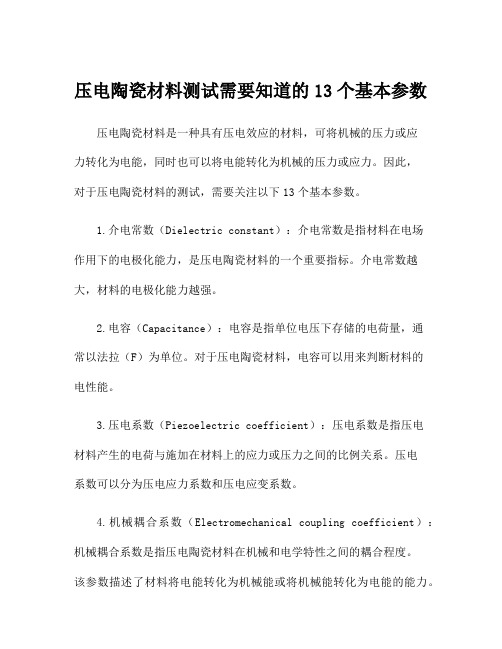
压电陶瓷材料测试需要知道的13个基本参数压电陶瓷材料是一种具有压电效应的材料,可将机械的压力或应力转化为电能,同时也可以将电能转化为机械的压力或应力。
因此,对于压电陶瓷材料的测试,需要关注以下13个基本参数。
1.介电常数(Dielectric constant):介电常数是指材料在电场作用下的电极化能力,是压电陶瓷材料的一个重要指标。
介电常数越大,材料的电极化能力越强。
2.电容(Capacitance):电容是指单位电压下存储的电荷量,通常以法拉(F)为单位。
对于压电陶瓷材料,电容可以用来判断材料的电性能。
3.压电系数(Piezoelectric coefficient):压电系数是指压电材料产生的电荷与施加在材料上的应力或压力之间的比例关系。
压电系数可以分为压电应力系数和压电应变系数。
4.机械耦合系数(Electromechanical coupling coefficient):机械耦合系数是指压电陶瓷材料在机械和电学特性之间的耦合程度。
该参数描述了材料将电能转化为机械能或将机械能转化为电能的能力。
5.压电应用温度范围(Operating temperature range):压电陶瓷材料在不同温度下的性能是不同的,因此需要确定材料的工作温度范围。
过高或过低的温度可能会影响材料的性能。
6.力常数(Force constant):力常数是指压电材料在单位面积上所承受的力与电压或电荷之间的比例关系。
力常数可以用来描述材料的力学特性。
7.色散(Dispersion):色散是指压电陶瓷材料的压电性能随着频率的变化而产生的变化。
了解材料的色散特性可以优化材料的应用。
8.应力-应变曲线(Stress-strain curve):应力-应变曲线描述了在施加外力或压力时,材料的应力和应变之间的关系。
通过绘制应力-应变曲线,可以获得材料的力学性能。
9.电化学稳定性(Electrochemical stability):压电陶瓷材料应具有良好的电化学稳定性,以确保其在一定电压或电流下不发生电化学反应。
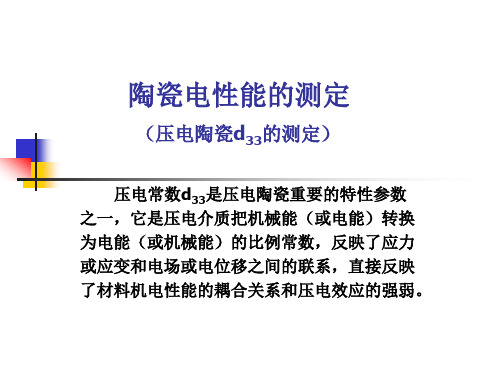

T=cS(1-6)式中,S为弹性顺度常数,单位为m2/N;C为弹性劲度常数,单位为N/m2。
但是,任何材料都是三维的,即当施加应力于长度方向时,不仅在长度方向产生应变,宽度与厚度方向上也产生应变。
设有如图1-2所示的薄长片,其长度沿1方向,宽度沿2方向。
沿1方向施加应力T1,使薄片在1方向产生应变S1,而在方向2上产生应变S2,由(1-5)式不难得出S1=S11T1(1-7)S2=S12T1(1-8)上面两式弹性顺度常数S11和S12之比,称为迫松比,即(1-9)它表示横向相对收缩与纵向相对伸长之比。
同理,可以得到S13,S21,S22,其中,S22=S11,S12=S21。
极化过的压电瓷,其独立的弹性顺度常数只有5个,即S11,S12,S13,S33和S44。
独立的弹性劲度常数也只有5个,即C11,C12,C13,C33和C44.由于压电瓷存在压电效应,因此压电瓷样品在不同的电学条件下具有不同的弹性顺度常数。
在外电路的电阻很小相当于短路,或电场强度E=0的条件下测得的称为短路弹性顺度常数,记作S E。
在外电路的电阻很大相当于开路,或电位移D=0的条件下测得的称为开路弹性顺度常数,记作S D。
由于压电瓷为各向异相性体,因此共有下列10个弹性顺度常数:S E11,S E12,S E13,S E33,S E44,S D11,S D12,S D13,S D33,S D44。
同理,弹性劲度常数也有10个:C E11,C E12,C E13,C E33,C E44,C D11,C D12,C D13,C D33,C D44。
(4)机械品质因数。

压电陶瓷材料的主要性能及参数自由介电常数εT33(free permittivity)电介质在应变为零(或常数)时的介电常数,其单位为法拉/米。
相对介电常数εTr3(relative permittivity)介电常数εT33与真空介电常数ε0之比值,εTr3=εT33/ε0,它是一个无因次的物理量。
介质损耗(dielectric loss)电介质在电场作用下,由于电极化弛豫过程和漏导等原因在电介质内所损耗的能量.损耗角正切tgδ(tangent of loss angle)理想电介质在正弦交变电场作用下流过的电流比电压相位超前90 0,但是在压电陶瓷试样中因有能量损耗,电流超前的相位角ψ小于900,它的余角δ(δ+ψ=900)称为损耗角,它是一个无因次的物理量,人们通常用损耗角正切tgδ来表示介质损耗的大小,它表示了电介质的有功功率(损失功率)P与无功功率Q之比.即:电学品质因数Qe(electrical quality factor)电学品质因数的值等于试样的损耗角正切值的倒数,用Qe表示,它是一个无因次的物理量。
若用并联等效电路表示交变电场中的压电陶瓷的试样,则Qe=1/ tgδ=ωCR机械品质因数Qm(mechanical quanlity factor)压电振子在谐振时储存的机械能与在一个周期内损耗的机械能之比称为机械品质因数.它与振子参数的关系式为:泊松比(poissons ratio)泊松比系指固体在应力作用下的横向相对收缩与纵向相对伸长之比,是一个无因次的物理量,用δ表示:δ= - S 12 /S11串联谐振频率fs(series resonance frequency)压电振子等效电路中串联支路的谐振频率称为串联谐振频率,用f s 表示,即并联谐振频率fp(parallel resonance frequency)压电振子等效电路中并联支路的谐振频率称为并联谐振频率,用f p 表示,即f p =谐振频率fr(resonance frequency)使压电振子的电纳为零的一对频率中较低的一个频率称为谐振频率,用f r 表示.反谐振频率fa(antiresonance frequency)使压电振子的电纳为零的一对频率中较高的一个频率称为反谐振频率,用f a 表示。
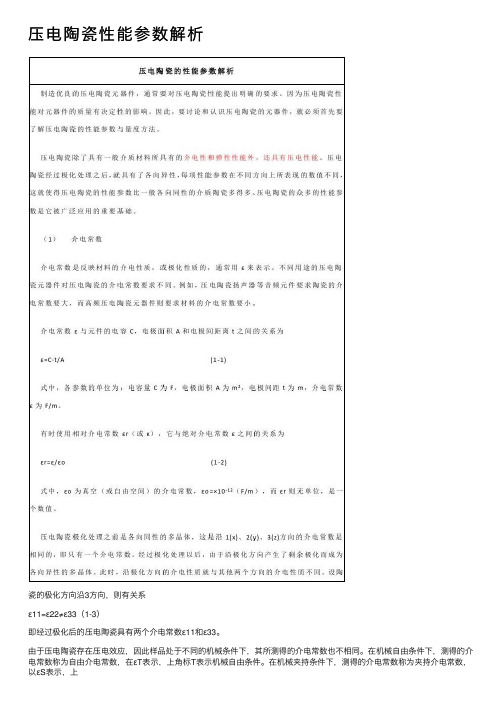
压电陶瓷性能参数解析瓷的极化⽅向沿3⽅向,则有关系ε11=ε22≠ε33(1-3)即经过极化后的压电陶瓷具有两个介电常数ε11和ε33。
由于压电陶瓷存在压电效应,因此样品处于不同的机械条件下,其所测得的介电常数也不相同。
在机械⾃由条件下,测得的介电常数称为⾃由介电常数,在εT表⽰,上⾓标T表⽰机械⾃由条件。
在机械夹持条件下,测得的介电常数称为夹持介电常数,以εS表⽰,上⾓标S表⽰机械夹持条件。
由于在机械⾃由条件下存在由形变⽽产⽣的附加电场,⽽在机械受夹条件下则没有这种效应,因⽽在两种条件下测得的介电常数数值是不同的。
根据上⾯所述,沿3⽅向极化的压电陶瓷具有四个介电常数,即ε11T,ε33T,ε11S,ε11S。
(2)介质损耗介质损耗是包括压电陶瓷在内的任何介质材料所具有的重要品质指标之⼀。
在交变电场下,介质所积蓄的电荷有两部分:⼀种为有功部分(同相),由电导过程所引起的;⼀种为⽆功部分(异相),是由介质弛豫过程所引起的。
介质损耗的异相分量与同相分量的⽐值如图1-1所⽰,Ic为同相分量,IR为异相分量,Ic与总电流I的夹⾓为δ,其正切值为(1-4)式中,ω为交变电场的⾓频率,R为损耗电阻,C为介质电容。
由式(1-4)可以看出,I R⼤时,tanδ也⼤;I R⼩时tanδ也⼩。
通常⽤tanδ来表⽰的介质损耗,称为介质损耗正切值或损耗因⼦,或者就叫做介质损耗。
处于静电场中的介质损耗来源于介质中的电导过程。
处于交变电场中的介质损耗,来源于电导过程和极化驰豫所引起的介质损耗。
此外,具有铁电性的压电陶瓷的介质损耗,还与畴壁的运动过程有关,但情况⽐较复杂,因此,在此不予详述。
(3)弹性常数压电陶瓷是⼀种弹性体,它服从胡克定律:“在弹性限度范围内,应⼒与应变成正⽐”。
设应⼒为T,加于截⾯积A的压电陶瓷⽚上,其所产⽣的应变为S,则根据胡克定律,应⼒T与应变S之间有如下关系S=sT(1-5)T=cS(1-6)式中,S为弹性顺度常数,单位为m2/N;C为弹性劲度常数,单位为N/m2。


压电陶瓷材料测试需要知道的13个基本参数压电陶瓷材料是一种能够通过施加电压或应力来产生机械变形,或者通过施加机械压力或应变来产生电荷分离的材料。
在压电陶瓷材料测试中,以下是13个基本参数,用于评估和分析材料的性能和特性。
1.压电系数(Piezoelectric Coefficient):表示压电陶瓷材料在单位电场下产生的机械应变或单位应变下产生的电荷。
具体包括压电应变系数和压电电荷系数。
2.介电常数(Dielectric Constant):指材料在外加电场下的电容率。
介电常数决定了材料的电介质性能。
3.机械质量密度(Mechanical Density):表示单位体积内材料的质量。
机械质量密度影响材料的力学性能。
4.晶体结构(Crystal Structure):描述压电陶瓷材料的晶体结构,如立方晶系、四方晶系等。
5.绝缘电阻(Insulation Resistance):表示材料对电流的阻抗能力。
绝缘电阻高表示材料的绝缘性能好。
6.介电损耗因子(Dielectric Loss Factor):表示压电材料在交变电源下的能量损耗。
7.压电耦合因子(Piezoelectric Coupling Factor):表示材料电能到机械能的转换效率。
该参数对于传感器和执行器的性能至关重要。
8.矢量震荡模式(Vector Resonance Mode):表示压电材料在特定频率下的最佳工作模式。
根据应用的需要,不同的矢量震荡模式可以选择。
9.饱和电压(Saturation Voltage):指材料在电场作用下的饱和电压值。
在此电压下,材料的压电响应达到最大。
10.功率密度(Power Density):表示材料转换电能到机械能的能力。
高功率密度表示材料具有更高的工作效率。
11.主谐波(Fundamental Resonance):表示材料在特定频率下的共振点。
主谐波频率是设计和优化压电材料应用的重要参考。
12.稳定性(Stability):指材料在温度、湿度和外界环境变化下的稳定性能。
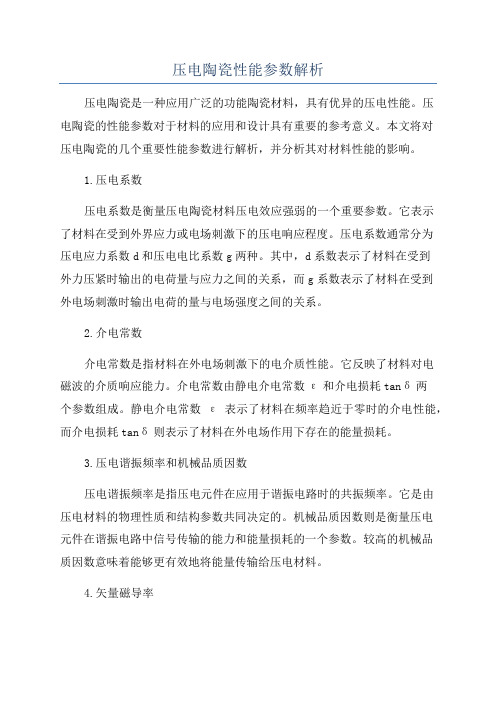
压电陶瓷性能参数解析压电陶瓷是一种应用广泛的功能陶瓷材料,具有优异的压电性能。
压电陶瓷的性能参数对于材料的应用和设计具有重要的参考意义。
本文将对压电陶瓷的几个重要性能参数进行解析,并分析其对材料性能的影响。
1.压电系数压电系数是衡量压电陶瓷材料压电效应强弱的一个重要参数。
它表示了材料在受到外界应力或电场刺激下的压电响应程度。
压电系数通常分为压电应力系数d和压电电比系数g两种。
其中,d系数表示了材料在受到外力压紧时输出的电荷量与应力之间的关系,而g系数表示了材料在受到外电场刺激时输出电荷的量与电场强度之间的关系。
2.介电常数介电常数是指材料在外电场刺激下的电介质性能。
它反映了材料对电磁波的介质响应能力。
介电常数由静电介电常数ε和介电损耗tanδ两个参数组成。
静电介电常数ε表示了材料在频率趋近于零时的介电性能,而介电损耗tanδ则表示了材料在外电场作用下存在的能量损耗。
3.压电谐振频率和机械品质因数压电谐振频率是指压电元件在应用于谐振电路时的共振频率。
它是由压电材料的物理性质和结构参数共同决定的。
机械品质因数则是衡量压电元件在谐振电路中信号传输的能力和能量损耗的一个参数。
较高的机械品质因数意味着能够更有效地将能量传输给压电材料。
4.矢量磁导率矢量磁导率是压电陶瓷材料对磁场的响应能力。
它由静磁导率和磁导率损耗θ两个参数组成。
静磁导率描述了材料对磁场的响应能力,而磁导率损耗θ则表示了材料在外磁场作用下存在的能量损耗。
这些性能参数对于压电陶瓷材料的应用具有重要的影响。
例如,较高的压电系数和介电常数意味着材料具有更强的压电效应和介电性能,适用于压电传感器和电控驱动器件等领域。
而较高的压电谐振频率和机械品质因数则意味着材料能够更好地应用于高频谐振器和滤波器等器件。
另外,矢量磁导率的大小对于磁声换能器和磁传感器的性能也有着重要的影响。
总之,了解和解析压电陶瓷的性能参数对于材料的选择和应用具有重要的意义。
不同性能参数的大小和综合能力决定了压电陶瓷的功能和应用范围。

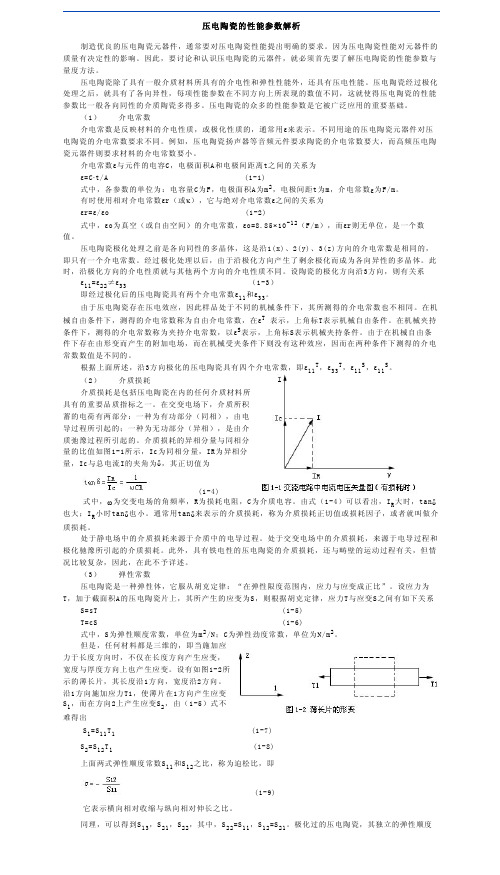

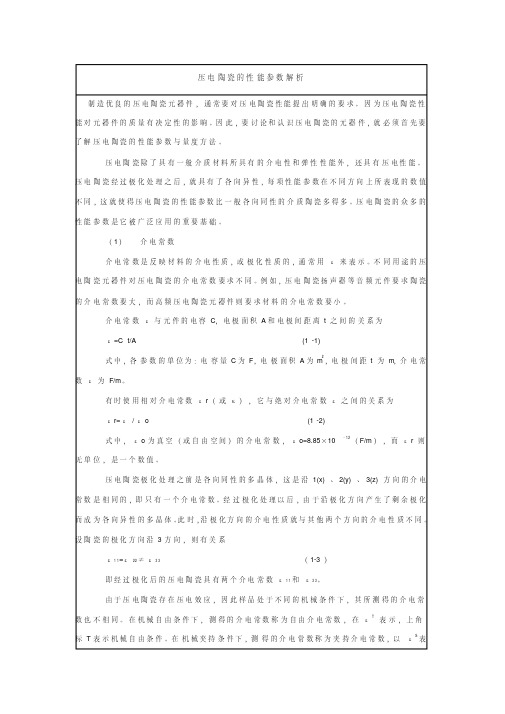
压电陶瓷的性能参数解析制造优良的压电陶瓷元器件,通常要对压电陶瓷性能提出明确的要求。
因为压电陶瓷性能对元器件的质量有决定性的影响。
因此,要讨论和认识压电陶瓷的元器件,就必须首先要了解压电陶瓷的性能参数与量度方法。
压电陶瓷除了具有一般介质材料所具有的介电性和弹性性能外,还具有压电性能。
压电陶瓷经过极化处理之后,就具有了各向异性,每项性能参数在不同方向上所表现的数值不同,这就使得压电陶瓷的性能参数比一般各向同性的介质陶瓷多得多。
压电陶瓷的众多的性能参数是它被广泛应用的重要基础。
(1)介电常数介电常数是反映材料的介电性质,或极化性质的,通常用ε来表示。
不同用途的压电陶瓷元器件对压电陶瓷的介电常数要求不同。
例如,压电陶瓷扬声器等音频元件要求陶瓷的介电常数要大,而高频压电陶瓷元器件则要求材料的介电常数要小。
介电常数ε与元件的电容C,电极面积A和电极间距离t之间的关系为ε=C·t/A (1-1)式中,各参数的单位为:电容量C为F,电极面积A为m2,电极间距t为m,介电常数ε为F/m。
有时使用相对介电常数εr(或κ),它与绝对介电常数ε之间的关系为εr=ε/εo (1-2)式中,εo为真空(或自由空间)的介电常数,εo=8.85×10-12(F/m),而εr则无单位,是一个数值。
压电陶瓷极化处理之前是各向同性的多晶体,这是沿1(x)、2(y)、3(z)方向的介电常数是相同的,即只有一个介电常数。
经过极化处理以后,由于沿极化方向产生了剩余极化而成为各向异性的多晶体。
此时,沿极化方向的介电性质就与其他两个方向的介电性质不同。
设陶瓷的极化方向沿3方向,则有关系ε11=ε22≠ε33(1-3)即经过极化后的压电陶瓷具有两个介电常数ε11和ε33。
由于压电陶瓷存在压电效应,因此样品处于不同的机械条件下,其所测得的介电常数也不相同。
在机械自由条件下,测得的介电常数称为自由介电常数,在εT表示,上角标T表示机械自由条件。
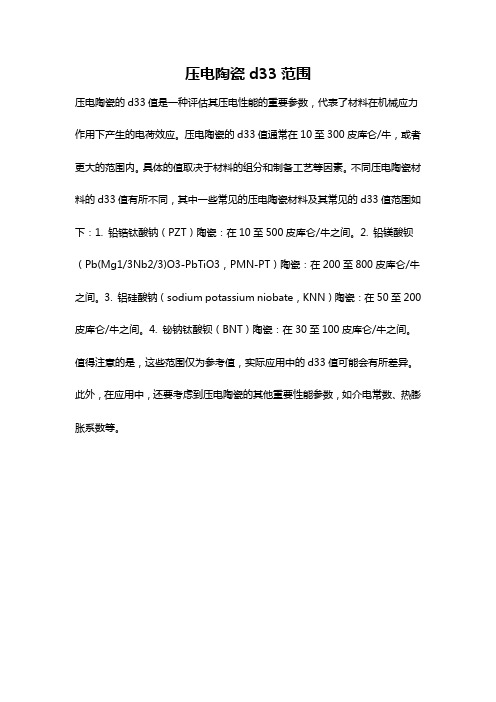
压电陶瓷d33范围
压电陶瓷的d33值是一种评估其压电性能的重要参数,代表了材料在机械应力作用下产生的电荷效应。
压电陶瓷的d33值通常在10至300皮库仑/牛,或者更大的范围内。
具体的值取决于材料的组分和制备工艺等因素。
不同压电陶瓷材料的d33值有所不同,其中一些常见的压电陶瓷材料及其常见的d33值范围如下:1. 铅锆钛酸钠(PZT)陶瓷:在10至500皮库仑/牛之间。
2. 铅镁酸钡(Pb(Mg1/3Nb2/3)O3-PbTiO3,PMN-PT)陶瓷:在200至800皮库仑/牛之间。
3. 铝硅酸钠(sodium potassium niobate,KNN)陶瓷:在50至200皮库仑/牛之间。
4. 铋钠钛酸钡(BNT)陶瓷:在30至100皮库仑/牛之间。
值得注意的是,这些范围仅为参考值,实际应用中的d33值可能会有所差异。
此外,在应用中,还要考虑到压电陶瓷的其他重要性能参数,如介电常数、热膨胀系数等。
